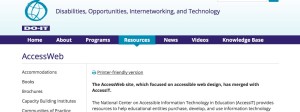 I am privileged work in IT for a university that is committed to diversity, equity, and inclusion for all. This includes a rock-solid commitment to accessibility. Our campus IT group provides a variety of technology services to accommodate students, staff and faculty with different abilities and needs.
I am privileged work in IT for a university that is committed to diversity, equity, and inclusion for all. This includes a rock-solid commitment to accessibility. Our campus IT group provides a variety of technology services to accommodate students, staff and faculty with different abilities and needs.
It is time, however, to kick it up a notch. As the head of the IT department, I’m preparing to challenge our group to come up with a campus IT strategy for Universal Design (UD) to address learning and working on our campus. We already employ UD principles in our work, but we’ve yet to collaborate with faculty and student leaders to publish a comprehensive strategy.
This is certainly a wicked problem. We work in an environment regulated by the state to ensure that everyone has equal access to our university. This is great, but regulations often lag behind new ideas For example, best practices in web accessibility are constantly changing for the better. Check Washington State’s DO-IT website for examples.
Technology is lagging too. Wouldn’t it be great to automatically caption every single video that comes through our campus lecture capture system? This would move us from a strategy of accommodation to UD. Further, it would support students with hearing disabilities along with ELL students and other learning needs. However, we’ve yet to find an automatic captioning system that’s accurate enough to do this at scale. YouTube offers pretty good auto-captioning, but it still requires human intervention to make it 100%. When it comes to complex academic topics with specific vocabularies, 100% is the minimum. This is just one example where we need to make smart technology choices, including choices about when to wait for improvements.
Finally, we’ll ground our UD strategy in redesigning our learning environments for active learning. Currently, most of our learning spaces are configured as traditional lecture classrooms. Practices such as flipped classes, problem-based learning, connected learning, community-engaged learning, etc. also invite learners with more diverse needs. This is certainly a design project. For the purposes of my CEP817 class at Michigan State, I may need to narrow the focus to just the part of the strategy that deals with classroom technology, or with faculty development. But for now, I’m very excited to start out with a broad challenge.
